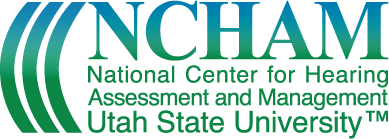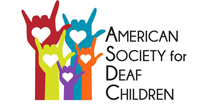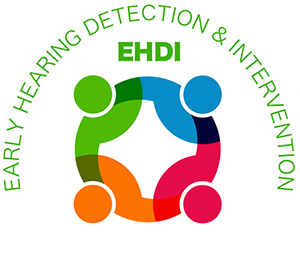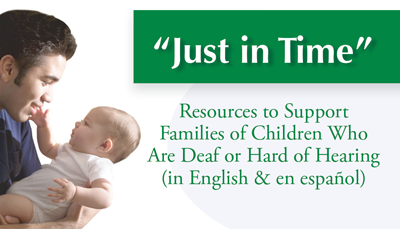Last Modified: 06/21/2023
"Just in Time" Resources to Support Families of Children Who Are Deaf or Hard of Hearing
Brought to you by the National Center for Hearing Assessment and Management and NCHAM’s Family Advisory Committee
This guide is a tool to help families of children who are deaf or hard of hearing (DHH) connect to family-tofamily supports with a focus on state-level resources. NCHAM encourages copying and posting this tool by EHDI and Part C programs, family support organizations, and health care providers. States are welcome to adapt it for their own use, adding resources unique to their state.
Just in Time Tool
The "Just in Time" tool [PDF] is designed especially for family organizations to help them in their job to support families. It contains the most essential resources identified by both families and professionals to address hearing-related needs. Family organizations, such as Family Voices, Family-to-Family Health Information Centers, Parent Training and Information Centers, and Parent-to-Parent USA chapters are invited to do the following:
- Post it on your website, allowing the hyperlinks to take the reader directly to critical information.
- Highlight the resource in your next staff meeting or conference call.
- Send it electronically to your local and state partners so they also can use it.
- Have it available as a hard-copy handout to share with families who prefer that format.
- Note the emphasis on resources with information available in other languages.
- Download the "Just in Time" tool (en español) [PDF]
- Click here to post this badge on your website
- Click here to post the Spanish language badge on your website
Essential Information
ehdiprograms.org

- Ensures that every baby receives a hearing screening and needed follow-up testing.
- Coordinates with early intervention and helps families get access to services.
- Ensures culturally-competent family support available to every family of an infant who is DHH.
- State specific contacts available at http://EHDIprograms.org/.
infanthearing.org

- Provides important information for families needing to connect with state newborn hearing screening programs.
- Features a Family Support Tab providing links to family organizations that can help families of children who are DHH.
- Print materials available: Communicate With Your Child booklets and “Learning about Hearing Loss: A Roadmap for Families”.
- State specific content available.
babyhearing.org
- Developed by Boys Town National Research Hospital.
- Answers questions about infant hearing screening and follow up testing, hearing devices, language & speech, and parenting issues.
- Available in Spanish and English.
A Parent's Guide to Hearing Loss
- Features programs and services about understanding hearing loss and how hearing is tested; finding professionals with expertise in serving babies with hearing loss; fitting a baby with a hearing device, and family support groups.
- Lists national organizations and state contacts.
- Available in Spanish and English.
By Families, For Families
handsandvoices.org

- Is a parent-driven organization to support all families of children who are DHH.
- Shares unbiased information about communication modalities, advocacy and more.
- Offers Guide By Your Side program: one-on-one family to family connections to support families with newly-identified children.
- Promotes Family Leadership in Language and Learning (FL3): resources to strengthen family leadership, support child language, literacy, social skills and DHH adult connections.
- State specific content available.
- Multiple languages: English, Spanish, Russian (more languages on local chapter pages).
familyvoices.org/ncfpp: Family-to-Family Health Information Centers (F2Fs)
- Family-led organizations in every state that connect families to peer support, including under served populations.
- Provides information, education, training, support and referral services.
- Print materials available.
- State-specific contacts available.
- Multiple languages: over 90 language options.
parentcenterhub.org/find-your-center: Parent Training and Information Centers (PTI’s) and Community Parent Resource Centers (CPRCs)

- Works with families of infants, toddlers, children, and youth with disabilities, including those who are DHH, ages birth to 26.
- Helps parents participate effectively in their children’s education and development.
- Partners with professionals and policy makers to improve outcomes for all children with disabilities.
- Print materials available.
- State-specific contacts available.
- Multiple languages: available via most state-specific links.
p2pusa.org

- Offers emotional & informational support for families of children who have special needs, including those who are DHH.
- Provides parents with one-to-one “match” with experienced, trained volunteer support parents.
- Assists parents in finding information and resources.
- State chapters in most states as well as neighboring state support.
- Multiple languages: available via most state-specific links.
More Resources
ehdi-pals.org: Early Hearing Detection & Intervention - Pediatric Audiology Links to Services

- Has a national web-based directory of places that offer pediatric audiology services to children ages birth to five.
- Helps families to find local providers.
- Allows providers to enter their information so that they can reach clients.
- State and local level contact information available.
clerccenter.gallaudet.edu
- Offers family supports to early language and early intervention for babies who are DHH.
- Provides strategies on how to read to children who are DHH.
- Produces “Odyssey: New Directions in Deaf Education”, theme-based magazine focusing on best practices in educating DHH children.
- Materials available in Spanish, English, and ASL.
agbell.org
- Offers information about options and considerations on how to select a communication approach for their child. Especially useful for families using a listening and spoken language approach.
- Provides information and resources to help families learn how to provide access to communication as early as possible.
deafchildren.org

- Promotes access to communication- rich environments.
- Supports and educates families as well as advocates for access to information about communication and literacy.
- Emphasizes the benefits of using visual language with young children.
cuedspeech.org

- Provides resources for using cued speech - a visual mode of communication in which mouth movements of speech combine with “cues” to make the sounds (phonemes) of traditional spoken languages look different.
- Offers links to special cued speech instructors.
- Focuses on the role of cued speech in promoting language and literacy.
Hearing First
- Supports families and professionals to help infants and toddlers who are deaf or hard of hearing achieve listening, spoken language, and literacy opportunities with Listening and Spoken Language (LSL).
- Familiar Sounds Audiogram
- Find Your Way Guide
Families Often Ask...
I’m concerned about my baby’s hearing and wonder if she has a hearing loss. Who can help me?
- EHDI Programs find your state’s EHDI coordinator
- EHDI PALS – find a pediatric audiologist in your community
- My Baby’s Hearing
- CDC – A Parent's Guide to Hearing Loss
I'd like to know more about different ways to communicate with my baby- where can I get information?
- Hands & Voices
- My Baby’s Hearing
- CDC – A Parent’s Guide to Hearing Loss
- American Society for Deaf Children
- AG Bell
- National Cued Speech Association
- Clerc Center
Who can connect me with other parents of children who are deaf or hard of hearing?
- Hands & Voices
- Parent to Parent USA
- EHDI Programs find your state’s EHDI coordinator
- American Society for Deaf Children
- AG Bell
- Family-to-Family Health Information Centers
My child has other needs in addition to hearing. Who can help me get information about other disabilities or health conditions?
- Family-to-Family Health Information Centers
- Parent Training and Information Centers
- Parent to Parent USA
I don’t think my child is getting the early intervention services they need. Where can I learn more about my child’s early intervention and educational rights?
- Parent Training and Information Centers
- Family-to-Family Health Information Centers
- Hands & Voices
- Clerc Center
Is there money available to get help to pay for hearing aids or other technology and services?
- Family-to-Family Health Information Centers
- NCHAM: Hearing Aid Loaner Bank Programs & Legislation
- Hearing Loss Association of America Financial Assistance
- AG Bell
This has been funded in part by a cooperative agreement (U52MC04391) from the Maternal and Child Health Bureau (MCHB) of the Health Resources and Services Administration (HRSA) at the United States Department of Health and Human Services.


